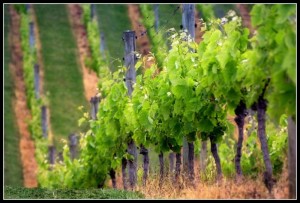 This is the time of year we all rejoice to welcome – the days grow longer, the sun grows stronger, the snowbanks recede, and the first fresh produce of the season makes its way to our outdoor patio tables. This is the time when the crisp, bright white wines from France’s upper Loire River valley come into their own. Sancerre is the most famous of these, and is reputed to have been Ernest Hemmingway’s favourite white wine, and one of mine, too. The neighbouring villages of Pouilly-sur-Loire, Quincy, and Ménétou-Salon make similar wines; what they all have in common is: they are made from the Sauvignon blanc grape grown on limestone soils. These are among the most distinctive of all white wines; their characteristic herbaceous, grassy aroma is very easily learned – some wine writers say it smells like gooseberries, but personally I don’t find that very helpful.
This is the time of year we all rejoice to welcome – the days grow longer, the sun grows stronger, the snowbanks recede, and the first fresh produce of the season makes its way to our outdoor patio tables. This is the time when the crisp, bright white wines from France’s upper Loire River valley come into their own. Sancerre is the most famous of these, and is reputed to have been Ernest Hemmingway’s favourite white wine, and one of mine, too. The neighbouring villages of Pouilly-sur-Loire, Quincy, and Ménétou-Salon make similar wines; what they all have in common is: they are made from the Sauvignon blanc grape grown on limestone soils. These are among the most distinctive of all white wines; their characteristic herbaceous, grassy aroma is very easily learned – some wine writers say it smells like gooseberries, but personally I don’t find that very helpful.
Sauvignon blanc, sometimes called fumé blanc, has become one of those international grapes that is now grown around the world, but I have never had one from Chile, California, Australia or Canada that really appealed to me. The big exception is New Zealand, where a richer, fruitier style of Sauvignon blanc has become that country’s signature wine. They can be very good and are definitely worth trying, but I find they lack the lip-smacking crisp definition of the originals from the Loire valley.
Sancerre also happens to be one of the most picturesque wine towns in all of France. Situated high on a bluff overlooking the Loire River, it streets are a maze of cellars and shops where you can buy direct from the producers. An old Roman viaduct, still in use today, connects it with the other side of the river. Ménétou-Salon is a tiny village, worth adetour just to see their classic antique pissoir near the village centre.
What makes these wines the true wines of spring is the way they accompany the first vegetables of the new season, particularly fiddleheads and asparagus. While the first asparagus of spring is worthy of a celebration in itself – and in many European countries that is exactly what they do –it is a very difficult flavour to match with wine. It has its own unique bitter pungency that can spoil the flavour of most red wines. But anicely-chilled Sancerre – pulled from that lingering snowbank just off the edge of the deck – makes a magical match with this most delectable spring treat. Seek out a good chèvre – the soft white goats-milk cheese that hails from the same region – and you have the makings of one of the most perfect food and wine pairings in all cuisine.
The other nice thing about these wines is that they are not particularly expensive. The LCBO regularly has Sancerre and Ménétou-Salon on offer through their Vintages department in the $20 to $30 range. If you like you can pay more for upscale bottlings from premium producer Pascal Jolivet. Watch for the words Mise en bouteille au Domaineor the name of the producer as propriétaire-récoltanton the label if you are looking for a truly authentic experience. But these wines are of consistently high quality and represent very good value. They don’t require ageing in your cellar – enjoy them while stillfresh and young.
First published in Bayview Magazine, Thunder Bay, Canada
